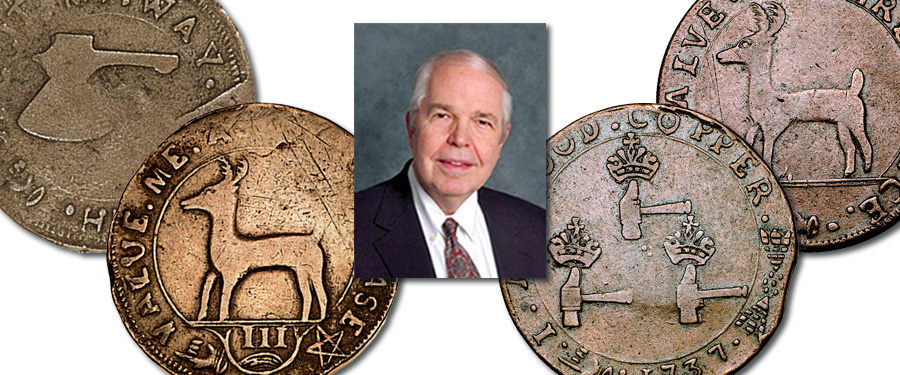
Among the most interesting of all early American issues are the copper tokens struck circa 1737-1739 by Dr. Samuel Higley, of Granby, Connecticut. Higley, a medical doctor with a degree from Yale College, also practiced blacksmithing and performed many experiments involving metallurgy. In 1827 he devised a practical method for producing steel.
In 1728 Dr. Higley purchased property on a hill near Granby that contained copper ore. Following his purchase, he operated a small but thriving mining business which extracted exceptionally rich copper. Much if not most of the metal was exported to England. Sometime around 1837, Higley produced a copper token. The obverse depicted a standing deer with the legend THE VALUE OF THREE-PENCE. The reverse showed three crowned hammers with the surrounding legend, CONNECTICUT, and the date 1737.
Legend tells that drinks at the local tavern sold at the time for three pence each, and Higley was in the habit of paying his bar bill with his own coinage. There was a cry against this because the Higley copper threepence was of a diameter no larger than the British halfpennies which circulated in the area, coins that had a value of just 1/6th of that stated on the Higley coin. Accordingly, Higley redesigned his coinage so that the obverse legend was changed to read VALUE ME AS YOU PLEASE. The pieces still bore an indication of value, the Roman numeral III below the standing deer. Two new reverses were designed, one of which pictured three hammers with the inscription I AM GOOD COPPER. The other reverse, picturing a broad axe, had the legend I CUT MY WAY THROUGH. The third obverse design, of which only a single specimen is known, depicted a wagon wheel with the legend THE WHEEL GOES ROUND.
While on a voyage to England in May 1737, on a ship loaded with copper from his own mine, Samuel Higley died. His oldest son, together with Rev. Timothy Woodbridge and William Cradock probably engraved and struck the issues of 1739.
Apparently the original Higley coinage was small and circulation was effected mainly in Granby and its environs. Sylvester S. Crosby related that a goldsmith, who served his apprenticeship around 1810, told that Higley pieces were hard to find at the time and were in demand to use as an alloy for gold. The goldsmith related that his master delayed completing a string of gold beads because he was unable to find a copper Higley threepence with which to alloy the metal.
Today, Higley issues of all types are exceedingly rare, and often a span of years will occur between offerings. Nearly all pieces show very extensive evidence of circulation, with most grading in the range of Good or Very Good.





